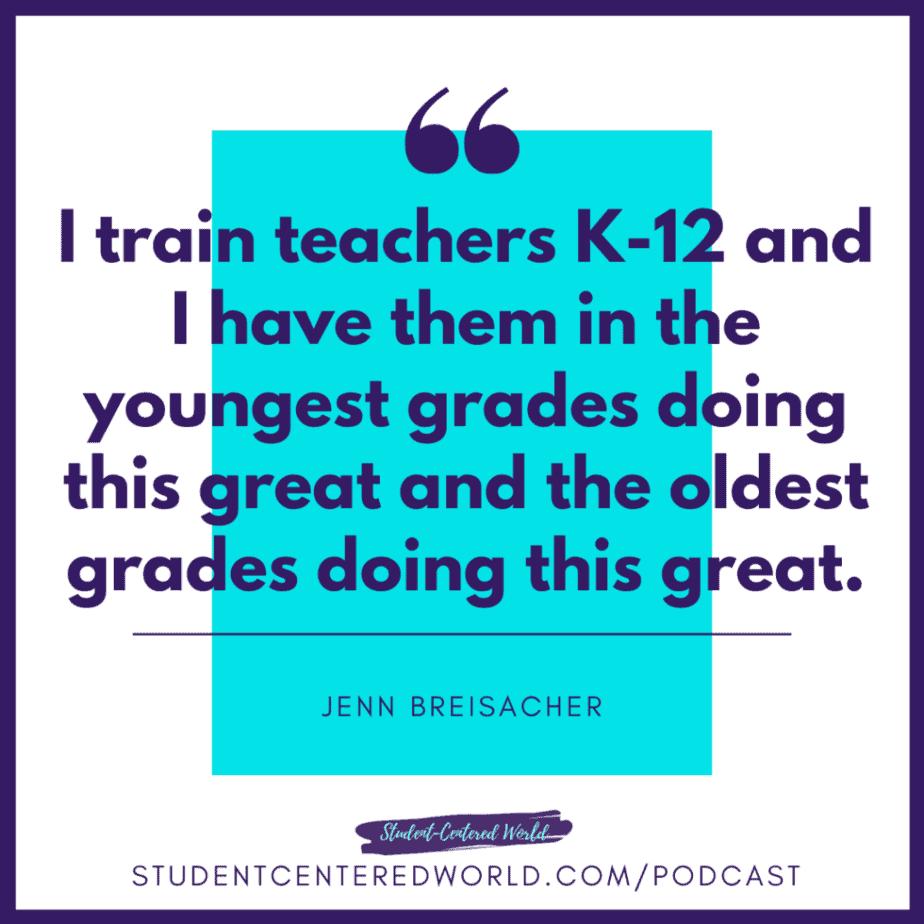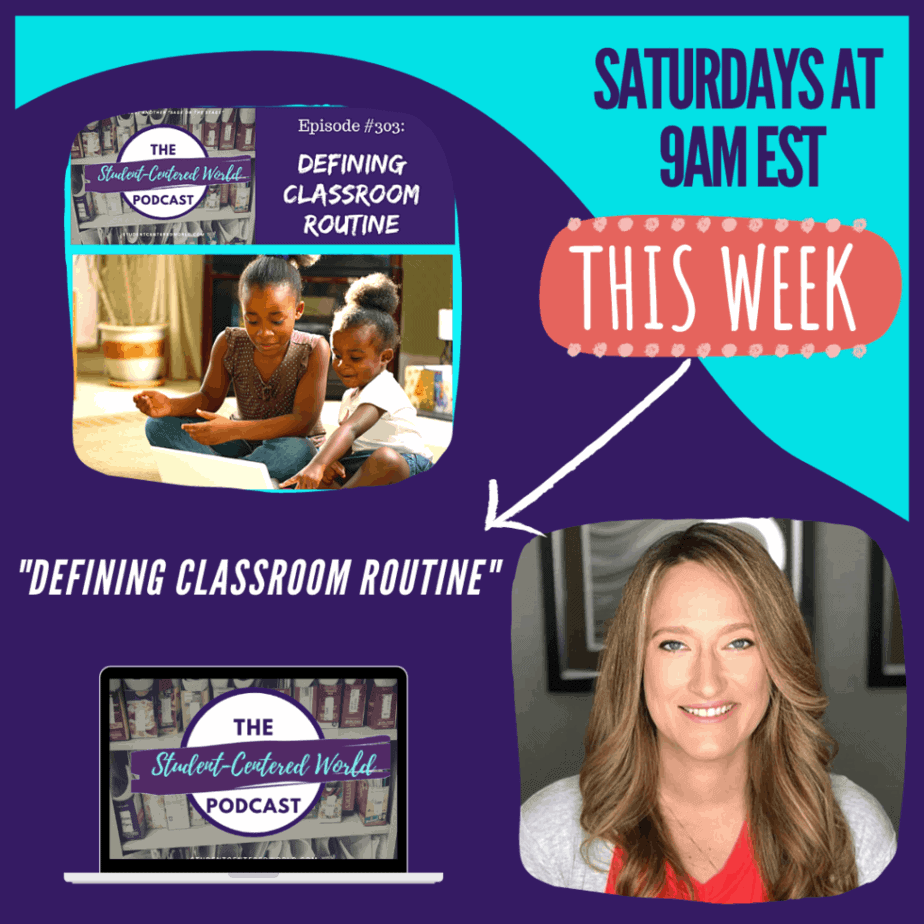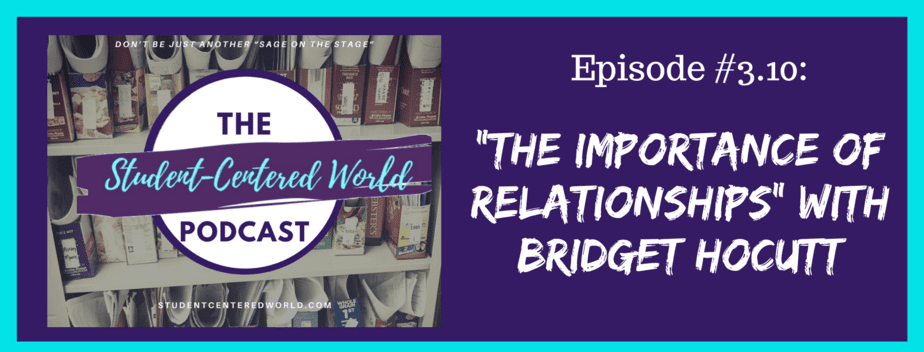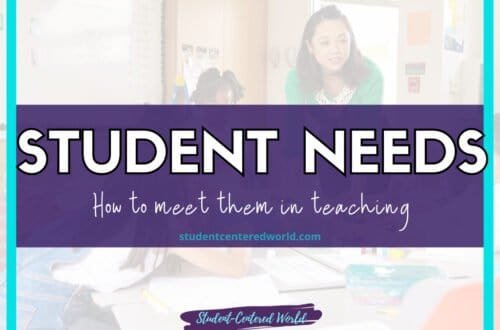A Great K-12 Classroom Routine: Defining Protocols
Click above to listen to this podcast episode. Below is the transcript for Student-Centered World Podcast Episode 19: “Defining Classroom Routine”
Hey, everybody. So today I wanted to take a couple of minutes to talk about classroom routine. So, if you listened for the last two weeks, you know that in the first episode we had talked all about engagement. It was clipped out of the engagement webinar that I was giving over the summertime and then last week, we talked to Bridget Burlage, who talked all about how she engages her students through classroom routine.
But there are some questions because my engagement piece was all about switching things up in the classroom and keeping the kids on their toes. Then Bridget went in and talked about how you have to have very distinct routines and it seems like they’re conflicting thoughts, but they are not. And I wanted to take a couple of minutes today to explain how they both work together in perfect harmony in classroom routine.
Welcome to the Student-Centered World podcast where we talk about all things hands-on teaching and keeping your energy and sanity in the classroom. This teacher turned consultant is making it her mission to help as many teachers as possible become the best version of themselves and keep their passion for teaching on fire. It’s her hope that we never forget why we desire to have a passion for educational progress. This is Student-Centered World, and this is Jenn Breisacher.
Alright, so clarity time and you might want to get a pencil and a piece of paper because you might have some ideas as you’re going through this to jot down for ideas in your own classroom routine. So, talking about the routine, we know that our students thrive on routine. As humans, we all thrive on routine. We want to know what’s kind of expected, what’s expected of us, and what we need to do to do well. So that is what Bridget’s podcast was all about.
She knows she has her students for an hour a day, so as part of her classroom routine, she splits that hour into 20 minutes segments and each one is separated into a different theme or topic or whatever it is that she has to do within her curriculum. That’s a really great idea, I would highly suggest that you figure out what your timing is, what you need your students to do, and how you want that to look.
Now, how that looks, though, is a little bit different and that’s when it comes to what I was speaking on when we were talking about engagement and classroom routine. So, what you have is this scenario where your students come into class every day, and they know exactly what they need to do. They know exactly where they need to go.
So, if you are a classroom that is mainly digital, and that’s either in the classroom, or virtual or blended, or whatever the situation may be, the students know that they go on and they log into Google Classroom or they log to your teacher web page, they know exactly where they need to go to find out what the plan is or if you’re not a tech-heavy school, they know they come in and they look at the right bulletin board that has some type of a schedule or they go to a table where they know there’s going to be a scheduled plan laid out for them.
The possibilities really are endless, but you need to start your class or your subject period or whatever, with the same routine so your students know exactly where to start. Now, the engagement piece of that is when they get in tune with what the routine is. They know what they have to do to start each day and then they know what’s expected of them moving forward. But they never know what to expect when it comes to what specifically they are doing.
So, I always talk about student choice as part of your classroom routine. We have a lot of interviews coming up this season where we talk about giving them all of these options but what you need to realize is as the teacher, you’re the one who’s creating all these options, you’re creating the plan. You might be giving the students the time and flexibility but you’re the one who’s saying, okay, we need to make sure we do X, Y, and Z.

These activities, this process, this teaching piece will make sure that we go over that. These things here are going to make sure that I can understand whether or not the students have retained or understand or can dive deeper into the information as part of my classroom routine. It’s all one big moving product. Again, throughout this whole season, we’re going to be talking about how you make that successful. But the students don’t come in with a routine where they know they sit down and they do this activity followed by this activity, followed by this activity.
They know they have to sit down and get ready, but they never quite know what the activities are going to be. And those activities are going to be the ones that get them engaged, that get them excited, that give them some choice.
There are so many different possibilities for classroom routine, and these are all things that I go over on my website. We’re going to be talking about throughout the podcast, and it’s what really makes the difference between a student or a classroom that comes in and gets right to work and gives you that feeling of you’re making a difference.
They all get it and you’re watching them learn, or the discipline issues and the stress on your behalf of trying to do that sage on the stage routine, where you’re trying to make sure that you’re doing all the things and you have all these balls in the air at the same time. All of that gets eliminated, the stress level gets lower when you have the routine, but you’re also scheduling things out in a way that keeps your students engaged.
So, if I could hear your thoughts right now, it’s probably either questioning well, that kind of sounds good, or, you know, I don’t get it. That’s really normal. So, I train teachers, and I train teachers, K-12, and I have them in the youngest grades doing this great. The oldest grades doing this great. When I taught, I taught high school history, and how I would have this work is I would have a schedule printed out for the students every single day. We were on tech a lot, but I always liked having a tangible piece of paper for my students.
Now that’s one thing that you’re going to need to figure out. You might have a group that’s really great on screens all the time, or it might be divided, or it might be good to have a tangible piece of paper. That’s one of those things that as you go through this process you’ll figure out what your particular students will respond best to. So, they would get there.

Now mind you at the beginning of every single unit, I would give them a calendar, a schedule, like a curriculum guide of what we would be doing in that particular unit. So, they didn’t always have an idea of the grand scheme of things where we were, but when they met me at the door, I would hand them a piece of paper that had the schedule for the day.
So, it might be that we are going to be working on some type of simulation altogether, it might be alright, today is more of a choice day. So, these are going to be your options, or we’re going to split it into time. So, from this time to this time, everybody will be working on this. From this time to this time, we’ll be working on that.
Then I always had options in my classroom routine for my high-fliers that got through things quickly. If you get done early, here are some optional things that you can do, it might be getting ready for the next EdPuzzle that’s coming up, it might be helping other students with this project, because it’s very hands-on, and you could be a class ambassador for it. I always give options for every level of the student.
I think that’s one thing that we miss a lot, especially when we’re doing more whole-class instruction, where we have the teacher who is trying to reach everybody because that’s what we need to do. And we have a tendency to gravitate towards the kids who are struggling as we should.
But our high-flying kids, so many times are the ones that fall through the cracks fall off the cracks, maybe you want to think of it that way. But they don’t get as much face time, one on one time with the teacher because we take for granted that they get it and they’re going to do it and they’re fine.
Those kids are actually given a huge disservice because they are not challenged extra, or they’re not given the same personalization as some of the other kids. So, when you’re doing these assignments that create more hands-on activities, where you’re giving your students choice, where you’re letting them decide what it is that they’re going to do or how much time they need to do it within the scope of what you plan as the teacher, mind you.
You are still very much in charge of all of this as part of your classroom routine, you give the opportunity for every single student to have your attention in the exact same way. So, having that routine set where they know where to start, will then add in the engagement piece of they know the expectation of completing these assignments, of partaking in the activities, on doing the pieces of the curriculum that you layout for them.
Plus, it becomes a little bit exciting, especially if you’re doing, as I said, the simulations, the games, the activities, all of the pieces that we know that we know, as educators further learning, they’re going to come in every day and wonder what you’ve got up your sleeve. My students used to love walking into my classroom, and I used to love hearing them saying, “Mrs. B, you always come up with the craziest things.
You’re definitely the most unique teacher in this school” because I would find stuff and we would just try it we would go for it. We did pen pal projects with teachers all over the world. Instead of presentations, I would have them create little avatar characters that would give the presentation for them, especially if they were afraid of speaking in front of their peers or I would let them record stuff so they could still speak in front of their peers without actively doing it and be able to practice that skill, so they became more competent in that area.
It all works together in the end, and that’s what you need to make sure that you’re doing in your classroom routine. Doing this is not difficult. It’s taking what you already have and what you already use in your classroom routine and packaging it a little bit different in how you distribute it to your students. There are so many teachers that are nervous about doing this because they feel like they need to micromanage, they need to have their hand on every single thing that’s happening in your classroom.
When you are the one who’s conducting everything, you don’t need to be touching everything that’s happening, if you want to put it into like a visual aspect of that. You just need to make sure that your students know the expectation, know the routine and then you are giving them assignments, activities, whatnot, that are making their engagement spark naturally.
We have that stuff at our disposal. We know where to find it. We know the things that make them tick. It’s just a matter of how it gets presented to them. So, I hope that maybe you came up with some fun ideas for your classroom routine. from that. I hope it might have helped clarify anything from the last two podcasts that seems like it might have been conflicting.
Again, the routine and the engagement piece, work together hand in hand and once they mesh together in a way that works for you lowering stress levels, and works for your students in terms of getting them excited about their learning it is all cake from there.
If you have any questions about your classroom routine, you can certainly feel free to reach out to me at admin@studentcenteredworld.com. Also, make sure you subscribe to the podcast so that way you can hear us week after week. Enjoy the rest of your week.
Stop Driving the Teacher Struggle Bus
Are you struggling with student engagement, apathy, or keeping your class on track?
💫💫 There’s hope! 💫💫
Join my free teacher workshop “Choosing Choice” and in just 60 minutes, you’ll craft a practical plan to revitalize your teaching. Discover the magic of student choice in boosting engagement, gain quick implementation ideas, and explore strategies for year-long success.
Unlike overwhelming workshops, my approach guides you in real-time, providing more classroom options, reducing stress, and giving you more personal time.
Plus, you’ll earn a 1-hour professional development certificate and have 7 days of access.
Don’t miss this chance to transform your teaching; click below to secure your spot now!




